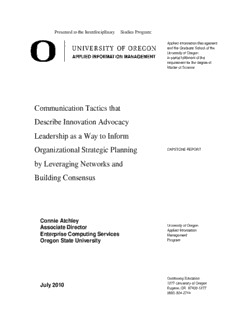
Communication Tactics that Describe Innovation Advocacy Leadership as a Way to Inform ... PDF
Preview Communication Tactics that Describe Innovation Advocacy Leadership as a Way to Inform ...
Presented to the Interdisciplinary Studies Program: Applied Information Management and the Graduate School of the University of Oregon in partial fulfillment of the requirement for the degree of Master of Science Comm unication Tactics that Describe Innovation Advocacy Leadership as a Way to Inform Organi zational Strategic Planning CAPSTONE REPORT by Leveraging Networks and Building Consensus Connie Atchley Assoc iate Director University of Oregon Applied Information Enterprise Computing Services Management Orego n State University Program Continuing Education July 2 010 1277 University of Oregon Eugene, OR 97403-1277 (800) 824-2714 Approved by ________________________________________________________ Dr. Linda F. Ettinger Senior Academic Director, AIM Program Running head: INNOVATION ADVOCACY TACTICS TO INFORM STRATEGY 1 Communication Tactics that Describe Innovation Advocacy Leadership as a Way to Inform Organizational Strategic Planning by Leveraging Networks and Building Consensus Connie Atchley Oregon State University Innovation Advocacy Tactics to Inform Strategy 2 Innovation Advocacy Tactics to Inform Strategy 3 Abstract This study presents six communication tactics that describe innovation advocacy leadership. It examines differences in communication abilities and behaviors represented by divergent processes, which develop new directions necessary to support innovative ideas, and convergent processes which represent the dominant organizational view necessary to support formal strategic planning (Pappas, 2004). Tactics provide advocates with a procedural bridge to the new ideas they propose and include defining innovation context, developing dynamic networks, channeling opportunities, and framing perceptions. Keywords: innovation advocate, divergent processes, strategy, communication, leadership Innovation Advocacy Tactics to Inform Strategy 4 Innovation Advocacy Tactics to Inform Strategy 5 Table of Contents Introduction to the Literature Review.................................................................................7 Purpose..............................................................................................................................7 Problem Area...................................................................................................................8 Significance.....................................................................................................................10 Audience..........................................................................................................................11 Outcome..........................................................................................................................12 Delimitations...................................................................................................................13 Topic..........................................................................................................................13 Topic focus.................................................................................................................13 Exclusions..................................................................................................................13 Intended audience......................................................................................................13 Time frame.................................................................................................................14 Literature collection...................................................................................................14 Documentation approach...........................................................................................15 Selection and evaluation criteria................................................................................15 Data Analysis Plan Preview..........................................................................................16 Writing Plan Preview....................................................................................................16 Definitions.............................................................................................................................18 Research Parameters...........................................................................................................22 Research Questions and Sub-questions.......................................................................22 Search Strategy..............................................................................................................23 Search terms...............................................................................................................23 Subtopic search terms................................................................................................23 Record of preliminary searches.................................................................................24 Literature resources....................................................................................................24 Search engines...........................................................................................................24 Databases...................................................................................................................24 Additional literature resources...................................................................................25 Evaluation Criteria........................................................................................................25 Currency.....................................................................................................................25 Authority....................................................................................................................25 Objectivity..................................................................................................................25 Quality........................................................................................................................26 Relevancy...................................................................................................................26 Content.......................................................................................................................26 Documentation Approach.............................................................................................26 Data Analysis Plan.........................................................................................................27 Conceptual analysis plan............................................................................................27 Coding procedures.....................................................................................................28 Writing Plan...................................................................................................................30 Annotated Bibliography......................................................................................................33 Review of Literature............................................................................................................50 Theme One: Differences Between Convergent and Divergent Processes in Strategic Planning..........................................................................................................................50 Innovation Advocacy Tactics to Inform Strategy 6 Characteristics of convergent and divergent processes.............................................51 Tension reinforced by strategy...................................................................................52 Interdependence of convergent and divergent processes ..........................................53 The value of social interdependence..........................................................................54 The value of procedural interdependence..................................................................55 Theme Two: Leadership Attributes of the Innovation Advocate..............................56 Attribute #1: Obsessive zeal......................................................................................57 Attribute #2: Conscientiousness................................................................................58 Attribute #3: Ability to balance creativity and process.............................................58 Conclusions...........................................................................................................................60 Communication Tactics That Support Innovation Advocacy Leadership...............61 Communication tactic #1: Build social capital..........................................................61 Communication tactic #2: Define innovation context...............................................62 Communication tactic #3: Channel opportunities......................................................63 Communication tactic #4: Develop dynamic networks.............................................64 Communication tactic #5: Leverage network audiences...........................................65 Communication tactic #6: Frame perceptions and focus attention............................65 References.............................................................................................................................67 Appendix A...........................................................................................................................75 Appendix B...........................................................................................................................79
Description: